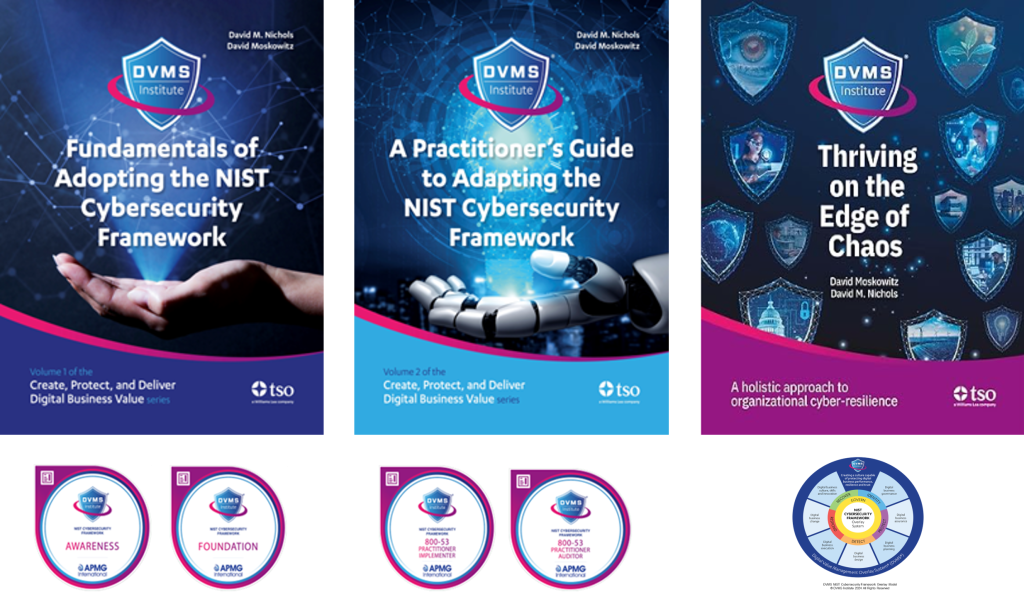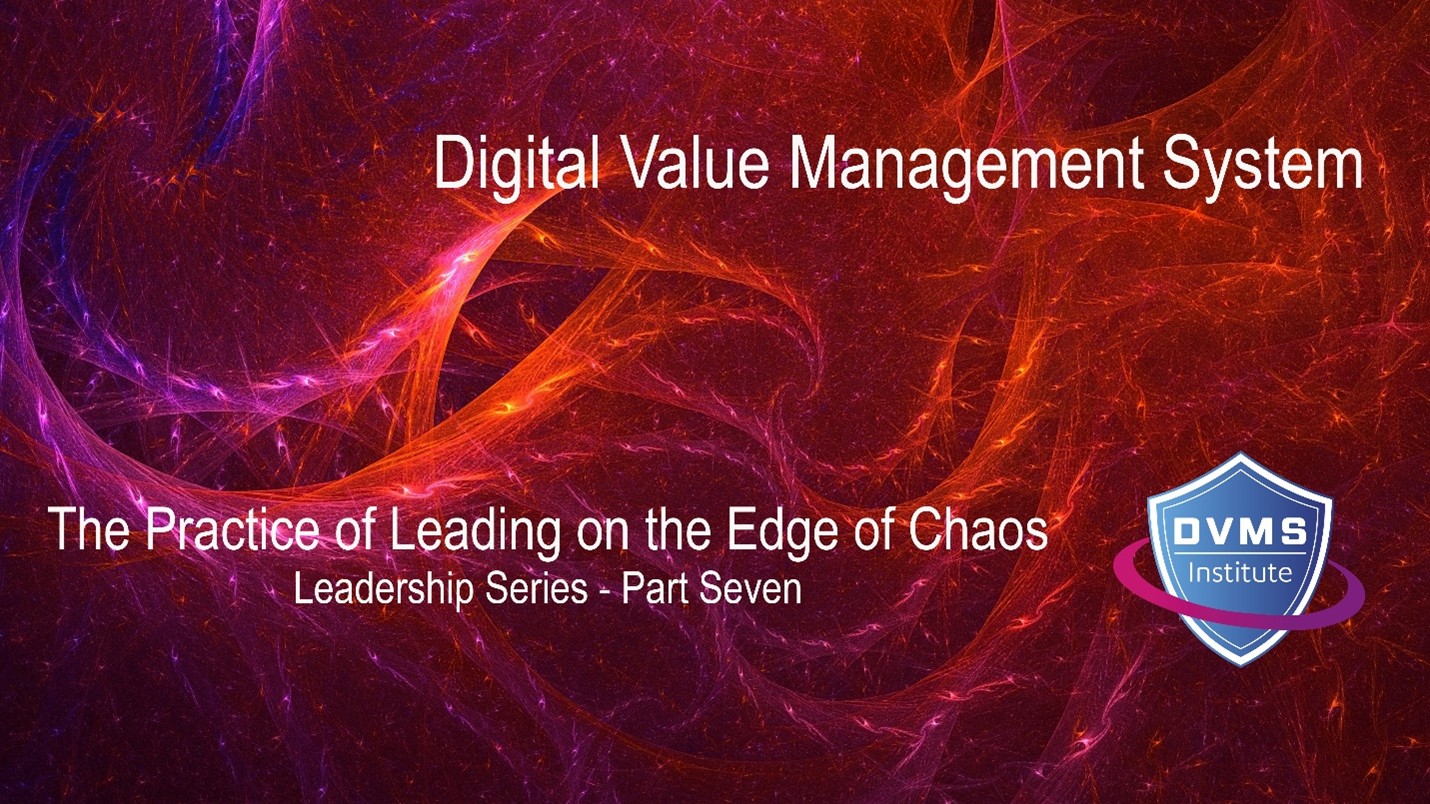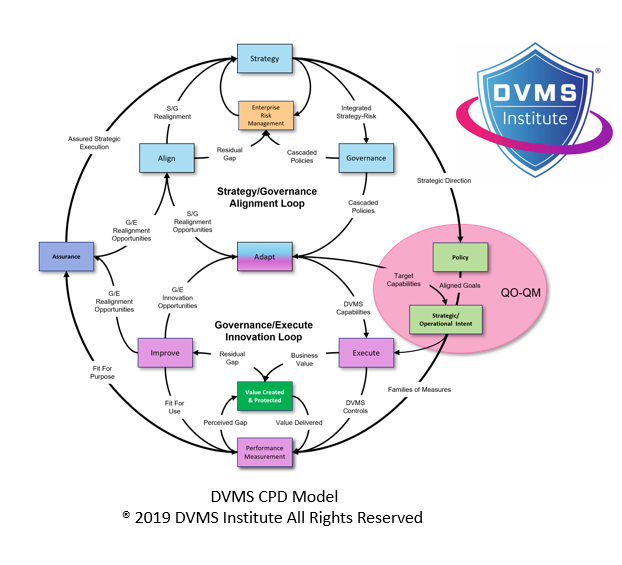Making Culture Visible -Using the DVMS 3D Knowledge Model to Align Leadership, Structure, and Behavior
David Nichols – Co-Founder and Executive Director of the DVMS Institute
Based on the DVMS Institute Publication Thriving on the Edge of Chaos
In an era where complexity and volatility define the business landscape, organizations face a painful truth: having the right tools, processes, and people is not enough. What matters most—what actually determines whether a company thrives or merely survives—is whether it can align its intent with its structure and its structure with the way people behave on the ground. In short, success is a question of congruence.
The original DVMS 3D Knowledge Model, as used in the DVMS approach, was designed to help organizations navigate complexity by modeling how strategic intent (Z-axis) is translated through governance and oversight (Y-axis) into operational capability (X-axis). However, working with organizations across various industries and maturity levels, I’ve found that something more powerful occurs when we reframe the model using more accessible, human-centered language.
Instead of Strategic Intent, Governance, and Operations, let’s call the axes:
- Leadership (Z-axis) – the origin of vision, values, and direction
- Structure (Y-axis) – the formal systems of control and coordination
- Behavior (X-axis) – what people actually do and why they do it
This isn’t just semantic substitution. It reveals something deeper: a systems view of organizational life where culture, capability, and performance are inseparable.
Leadership: The Energy Source of Organizational Life
Every organization projects an energy field—a collective gravity that shapes what people believe is possible, safe, rewarded, or off-limits. That energy originates on the Z-axis. In the reframed model, this is Leadership—not just the actions of the C-suite, but the totality of how the organization expresses its purpose, principles, and priorities.
Leadership serves as the narrative engine, answering the fundamental question: What kind of organization do we aspire to be?
When leadership is clear, aligned, and authentic, it fosters coherence. It makes it easier for individuals to understand what’s expected of them, take initiative without fear, and navigate trade-offs in uncertain situations.
But leadership isn’t a broadcast; it’s a behavior. It exists in how decisions are made, how language is used, how silence is interpreted, and how exceptions are managed. You can’t declare a purpose and then act in ways that contradict it. People notice.
When leadership on the Z-axis is inconsistent or performative, it creates a fog. People revert to the safety of known patterns. Innovation slows. Risk tolerance plummets. The center doesn’t hold.
Structure: The Silent Sculptor of Behavior
If leadership represents energy, structure serves as the medium through which that energy is channeled. It exists on the Y-axis—the realm of governance, roles, policies, workflows, and systems of accountability.
Structure answers the question: How do we organize, direct, and enable our work?
Effective structure translates leadership intent into design. It ensures that the operating model makes it easy for people to do the right thing and difficult to do the wrong thing. It establishes boundaries where necessary and flexibility where feasible. It provides decision rights, escalations, and feedback loops. When it functions well, people hardly notice it.
But structure is tricky. It’s largely invisible until it fails, which causes organizations to take it for granted. Or worse, they weaponize it. They confuse control with competence and use compliance mechanisms as substitutes for trust. In doing so, they create architectures of avoidance—systems that protect the organization from its own people.
When structure is misaligned with leadership, it sends a mixed signal. Leaders may claim to value innovation, but if approvals take weeks and failure is punished, structure tells a different story. And people always believe the structure.
Behavior: The Mirror of the System
At the ground level, on the X-axis, we find Behavior—the total accumulation of what people actually do. Not what the handbook states, not what the audit demands, but the informal, emergent, real-time navigation of daily work.
Behavior answers the question: What’s really going on here?
If you want to understand the true culture of an organization, don’t read its values statement—watch how it behaves under pressure. Observe who is promoted. Listen to how mistakes are handled. Look at where energy flows, what is celebrated, what is ignored, and what is quietly punished.
Behavior is not an outcome—it’s a signal. It reflects the quality of leadership and the effectiveness of structure. If behaviors are misaligned with stated goals, that is not a failure of individuals; it is a system message.
Too often, organizations attempt to change behavior through training, incentives, or new tools without addressing the structural and leadership foundations. That’s like painting over rust. It looks different for a while, but the corrosion continues.
Making the Models Congruent
So what happens when we make these models congruent—when Leadership, Structure, and Behavior align across the Z, Y, and X axes?
We get coherence.
Coherence doesn’t imply rigidity or lockstep conformity. It signifies that every part of the system is aligned in the same direction. Leadership articulates a clear vision, structure enables that vision, and behavior reinforces both.
Let’s look at what that feels like in practice.
In a Congruent Organization:
- Leadership emphasizes a commitment to customer-centricity. The structure incorporates cross-functional teams, flattens hierarchy, and empowers decision-making at the edges. Employee behavior reflects proactive problem-solving, escalating issues only when necessary, and innovating in small, rapid cycles.
- Leadership considers resilience a strategic priority. Structure offers clear incident response protocols, practices failover scenarios, and eliminates the stigma associated with raising concerns. Behavior emphasizes continuous learning, blameless retrospectives, and a culture of readiness over fear.
- Leadership fosters inclusion and belonging. Structure guarantees fair hiring practices, psychological safety, and meaningful employee input. Behavior encompasses diverse teams collaborating openly, challenging ideas without consequence, and addressing bias without fear of retaliation.
That’s coherence. And it feels like flow.
In an Incongruent Organization:
- Leadership talks about innovation, but structure requires three levels of approval for experimentation. Behavior becomes cautious, politicized, and performative.
- Leadership advocates agility, but structure enforces rigid stage gates and centralized command. Behavior becomes procedural, risk-averse, and cynical.
- Leadership expresses care for employees, but structure offers no flexibility, support, or transparency. Behavior becomes transactional, disengaged, and quietly rebellious.
That’s dissonance. And it feels like friction.
Why Congruence Is the Real Competitive Advantage
In a world where everyone has access to the same technologies, frameworks, and talent pools, the key differentiator is not what you possess—it’s how coherently you operate.
Congruence is what enables organizations to:
- Adapt quickly without losing direction
- Align distributed teams without micromanagement
- Maintain resilience in the face of disruption
- Build trust inside and outside the enterprise
- Scale culture without diluting it
It’s not about perfection; it’s about integrity—in the structural sense of the word. Like a well-designed bridge, a cohesive organization withstands stress because its components support one another.
How to Diagnose Congruence (or the Lack of It)
Congruence isn’t something you declare—it’s something you detect. It manifests in patterns, not slogans. Here are a few diagnostic questions to explore within your organization:
- Does our behavior reflect what our leaders say we value?
- Does our structure make it easy to act in alignment with our goals?
- Are there shadow systems, workarounds, or quiet resistances that signal misalignment?
- When something goes wrong, do we look for individual faults or system causes?
- Is our culture consistent across business units, geographies, and roles—or do we rely on heroic individuals to hold it together?
Answer honestly, and the system will reveal itself.
Congruence Is a Leadership Responsibility
If congruence is the key to resilience, trust, and performance, then leaders must act as stewards of coherence. This doesn’t imply controlling everything—it means aligning all aspects.
Leadership must extend beyond goal-setting. It must create frameworks that encourage desired behaviors and consistently exemplify those behaviors. It needs to bridge the gap between values and actions, policy and practice, strategy and capability.
That requires humility, systems thinking, and a willingness to question your own assumptions. It means not asking, “Why won’t people behave differently?” but instead asking, “What in our system makes this behavior rational?”
It means leading not by force, but by alignment.
Closing Thoughts: Coherence Is the Culture
In the end, culture is not something separate from structure or strategy. Culture is the emergent property of congruence—or the collateral damage of its absence.
When leadership, structure, and behavior are aligned, you don’t need posters to remind people of your values. They experience them. They reproduce them. They trust them.
That trust becomes your brand. That alignment becomes your engine. That coherence becomes your edge.
And in a world where the only constant is change, coherence is the only stability that lasts.
About the Author

Dave is the Executive Director of the DVMS Institute.
Dave spent his “formative years” on US Navy submarines. There, he learned complex systems, functioning in high-performance teams, and what it takes to be an exceptional leader. He took those skills into civilian life and built a successful career leading high-performance teams in software development and information service delivery.
In today’s digitally driven economy, cyber disruptions are no longer an “if” but a “when.”
The DVMS Institute’s Certified Training Programs teach organizations the skills to build a Holistic and Culture-Aligned Overlay System capable of coordinating Adaptive, Cyber Operations Governance, Resilience, and Assurance across a Complex Digital Ecosystem.
Achieving true cyber resilience across a complex digital ecosystem requires seamless alignment between organizational Strategy, Governance, and Operations, underpinned by a culture dedicated to sustaining and continuously innovating organizational digital value.

The DVMS positions cyber resilience as a strategic, enterprise-wide capability powered by the Institute’s CPD, Z-X, and 3D Knowledge models.
This systems-based approach to cyber operational resilience demands active engagement from all members of the Digital Ecosystem, with each member playing a distinct role in proactively identifying and mitigating the systemic risks that threaten digital business operations.
This adaptive, forward-looking approach to Governance, Resilience, and Assurance (GRA) positions businesses to:
- Maintain Operational Stability Amidst Constant Digital Disruption
- Drive Agility and Trust Across Your Digital Ecosystem
- Satisfy Critical Regulatory and Certification Requirements
- Leverage Cyber Resilience as a Competitive Advantage
DVMS Explainer Videos
- Architecture Video: David Moskowitz explains the DVMS System
- Case Study Video: Dr. Joseph Baugh Shares His DVMS Story.
- Overlay Model – What is an Overlay Model
- ZX Model – The MVC’s that power operational resilience
- CPD Model – Adaptable governance and assurance
- 3D Knowledge Model – Enabling holistic organizational learning
- FastTrack Model – A phased approach to cyber resilience
Digital Value Management System® is a registered trademark of the DVMS Institute LLC.
® DVMS Institute 2025 All Rights Reserved




